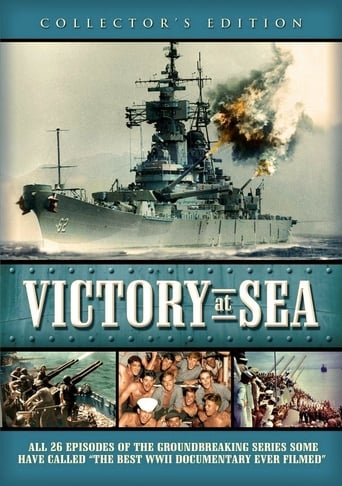michaelstep2004
A lot of people here seem to believe that the fantastic 13-hour score of Victory at Sea was composed by Richard Rodgers -- it was not. Rodgers contributed 12 short themes composed on piano, which were then expanded and orchestrated by the great Robert Russell Bennett, who also wrote of lot of extra music for this show not inspired by Rodgers. Rodgers always gave the credit to Bennett, saying that he made the music sound so much better than it really was.I watched this show repeatedly as a child, since it was rerun on TV continuously well into the 1960s. The episodes combine an obvious respect for the Allied sailors and soldiers who won the war with a sort of bumptious patriotism that was absolutely pervasive on TV in the 1950s. Good memories!
pandamorehead
All the other comments about this series are right on. This is a superb series that is a must for anyone interested in WWII. The archival footage is extensive and fascinating. Now, I just started viewing the 3 DVD set of this series. I must say, I'm a little disappointed. First, the print used is very worn. This may be due to haste, or it could be that all known prints are in really rough shape. Secondly, this appears to be a video of the film that was transferred to DVD. So what we are looking at is a somewhat blurry and worn version that is many generations (copies) old. Like I said, I'm a LITTLE disappointed, not a lot. Glad I got it.
frankfob
There isn't much to say about this fondly remembered series that hasn't already been said. This World War II documentary is just about as good as it gets. The writing, the music, the editing, the narration (which tends to get a bit pompous at times, but it's a small price to pay) are absolutely superb. Watching this is actually sort of a chilling experience; after awhile you begin to feel as if you've been transported on board the ships, or in the subs, or at Pearl Harbor, or on Iwo Jima--not just sitting in your living room watching it on TV. This series deserved every award it won, and more. It is a magnificent achievement, and nothing has equalled it since. Don't miss it.
rusty-52
I first watched this film series at the age of 13 and to say the least I was enchanted. Richard Rogers Music was a huge boost to a documentary that was unequaled then and since. The stark black and white film and the real footage went a long way in providing the realism. I found the Narration excellent along with the haunting refrains of Rogers' score in the background. I have watched the film all 26 episodes time and time again and of course have the original records including the one with sound effects. I strongly recommend the series to anyone interested in the History of World War 11 as it pertained to the U.S. Navy and Marine Corp.
